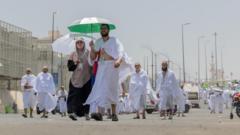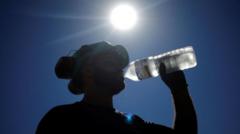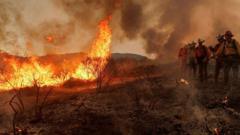Saudi Arabia has ramped up measures to prevent heat-related health issues as the Hajj pilgrimage gets under way in Mecca, with over 1.4 million Muslims participating this year. After last year's tragic incident where around 1,300 pilgrims reportedly died, mainly due to extreme heat conditions, Saudi authorities are taking proactive steps to protect attendees from the scorching sun, with temperatures anticipated to reach a high of 44°C (111°F).
Officials have implemented several safety protocols, including planting thousands of trees and installing over 400 cooling units throughout the pilgrimage sites to provide relief from soaring temperatures. In an effort to control attendance and ensure safety, the ministry has banned children under the age of 12 from entering the holy sites, imposing strict regulations that include the potential for hefty fines—up to $5,000—along with a 10-year ban for unregistered pilgrims caught attempting to enter Mecca without an official permit. Since the start of the pilgrimage, authorities have reportedly prevented more than 269,000 individuals from entering the city.
A significant proportion of last year's deceased pilgrims, primarily from nations like Egypt and Indonesia, were unregistered and lacked access to essential facilities like air-conditioned accommodations and safe transport, particularly as the temperature swelled to an alarming 51°C. Many Muslims seeking to perform the Hajj struggle with costs associated with official pilgrimage packages, which can range between $4,000 and $20,000 depending on their country of origin and desired comfort level, leading some to arrive on visitor visas.
The Hajj holds immense significance within Islam, constituting one of its five fundamental pillars, compelling every adult Muslim to undertake the journey at least once if financially and physically capable. Initiating this sacred journey, male pilgrims don two white garments, while female participants wear modest attire covering their heads but not their faces. A key ritual involves circumnavigating the Kaaba—Islam's holiest shrine—repeatedly as an expression of devotion.
To ensure a safe pilgrimage experience, health officials have reiterated guidelines emphasizing the importance of avoiding sunlight between 10 AM and 4 PM, utilizing umbrellas for shade, and staying hydrated. Expanded shaded areas now amount to an additional 50,000 square meters, with a sophisticated cooling system in the Grand Mosque touted as the largest globally. Enhanced infrastructural developments include rubberized and cooled roadways and artificial intelligence systems aiding in crowd management using drones.
Historical precedents of calamities such as a significant stampede in Mina in 2015 and recent fatalities underscore the importance of these measures as the Islamic community observes this pivotal moment in their religious calendar. Past incidents have raised concerns about the safety and conditions faced by pilgrims, prompting ongoing discussions around how to address and manage these challenges effectively as the spiritual journey unfolds.





















